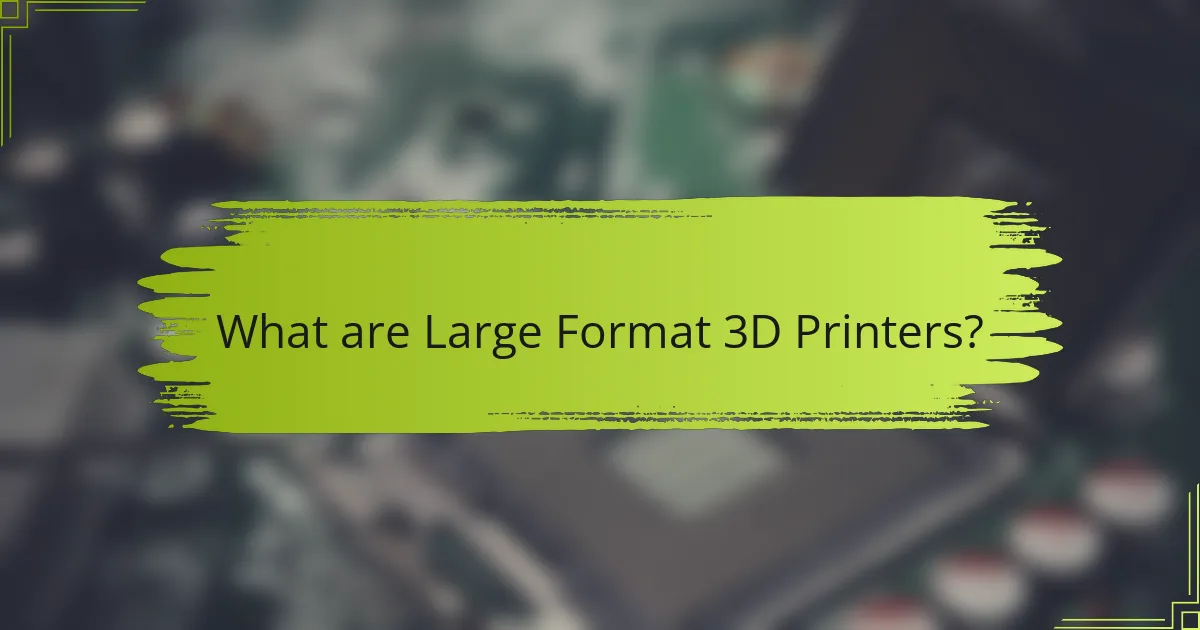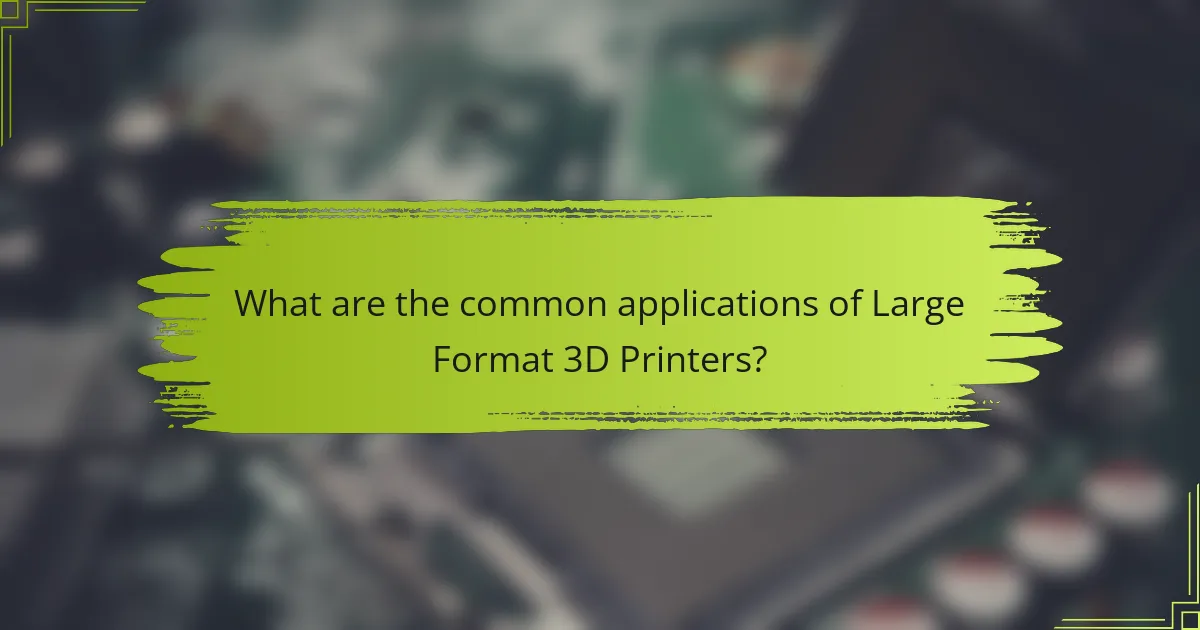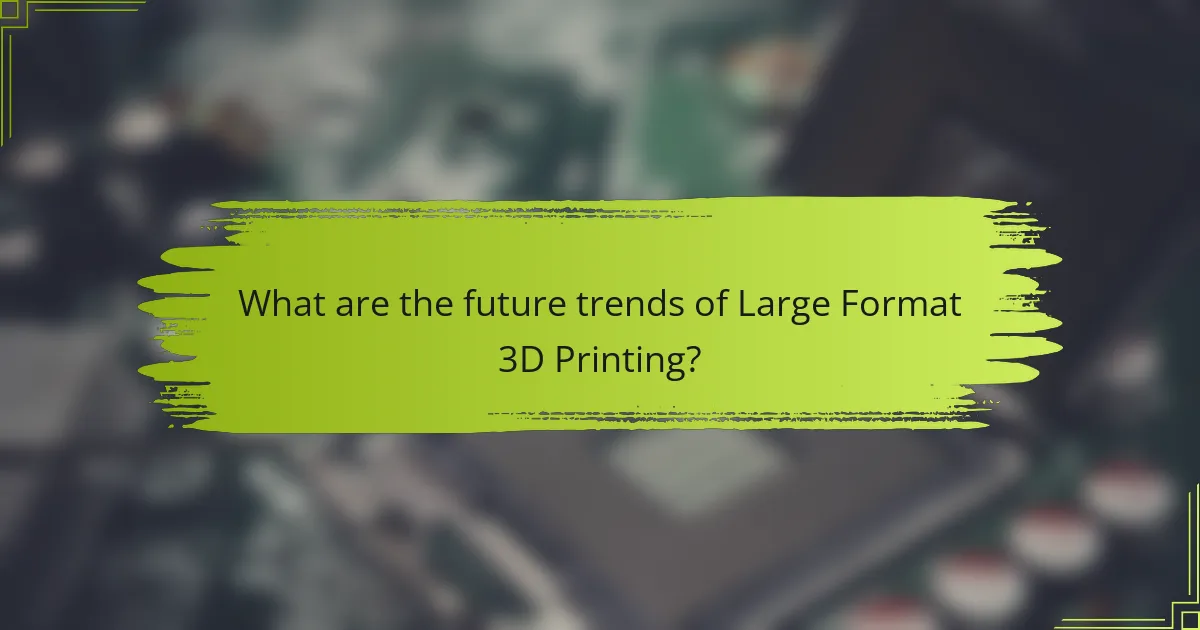
What are Large Format 3D Printers?
Large format 3D printers are machines designed to create large-scale three-dimensional objects. They utilize additive manufacturing techniques to build items layer by layer. This technology allows for the production of parts that exceed the typical dimensions of standard 3D printers. Large format printers can create objects ranging from several feet in length to custom sizes based on user specifications. They are commonly used in industries such as aerospace, automotive, and architecture. These printers often employ materials like plastics, composites, and metals. Their ability to produce large prototypes and end-use parts efficiently makes them valuable in various applications.
How do Large Format 3D Printers differ from standard 3D printers?
Large Format 3D Printers differ from standard 3D printers primarily in their build size. Large Format 3D Printers can create objects that exceed typical dimensions, often producing parts over 1 meter in length. This capability allows for the manufacturing of larger prototypes, molds, and end-use parts. Standard 3D printers usually have a maximum build volume of around 20 to 30 centimeters in each dimension. The larger size of Large Format printers enables the production of more complex geometries in fewer pieces. Additionally, they often require more advanced materials and higher power consumption due to their size. The precision and speed of Large Format printers can also vary, sometimes sacrificing speed for larger output.
What are the key specifications of Large Format 3D Printers?
Key specifications of large format 3D printers include build volume, layer resolution, and material compatibility. The build volume often exceeds 1 cubic meter, allowing for larger prints. Layer resolution typically ranges from 50 to 300 microns, affecting print detail. Material compatibility includes a variety of thermoplastics, composites, and metals. Print speed can vary, with some models achieving over 100 mm/s. Connectivity options often include USB, Ethernet, and Wi-Fi for ease of use. Additionally, advanced features may include multi-material printing and automated calibration systems. These specifications ensure large format 3D printers meet diverse industrial needs.
What types of materials can be used in Large Format 3D Printing?
Large format 3D printing can utilize a variety of materials. Common materials include thermoplastics such as ABS, PLA, and PETG. These plastics are widely used due to their availability and ease of printing. Additionally, materials like nylon and TPU offer enhanced flexibility and strength. Composite materials, including carbon fiber and fiberglass reinforced plastics, provide added durability. Metal materials, such as aluminum and titanium, are also suitable for large format 3D printing. Each material type has specific attributes that cater to different industrial applications.
What advantages do Large Format 3D Printers provide?
Large format 3D printers offer several advantages, primarily their ability to produce large-scale objects. This capability allows for the creation of prototypes and end-use parts in a single print, reducing assembly time. They also enable the manufacturing of complex geometries that may not be feasible with traditional methods. Additionally, large format 3D printers can utilize a variety of materials, including plastics and metals, enhancing versatility. Their efficiency in producing large quantities can lower production costs per unit. Furthermore, these printers support rapid prototyping, facilitating faster design iterations. Overall, large format 3D printers significantly enhance productivity and innovation in various industries.
How do Large Format 3D Printers enhance production efficiency?
Large Format 3D Printers enhance production efficiency by enabling the creation of larger parts in a single print. This reduces the need for assembly, saving time and labor costs. They also allow for rapid prototyping, which accelerates the design process. The ability to print multiple parts simultaneously further increases throughput. According to a study by Wohlers Associates, large format printers can cut production times by up to 50%. This efficiency leads to lower material waste and optimized resource use. Overall, these printers streamline manufacturing processes significantly.
What cost savings can be achieved with Large Format 3D Printers?
Large Format 3D Printers can achieve significant cost savings through reduced material waste and lower production costs. They enable the fabrication of large parts in a single print, minimizing the need for assembly. This reduces labor costs associated with assembly and finishing processes. Moreover, these printers often use less expensive materials compared to traditional manufacturing methods.
For example, studies indicate that 3D printing can reduce production costs by up to 70% in some industries. This is particularly evident in aerospace and automotive sectors, where large parts can be produced on-site, decreasing shipping and handling costs. Additionally, the ability to quickly iterate designs lowers the costs associated with prototyping.
Overall, the efficiency and flexibility of Large Format 3D Printers contribute to substantial financial savings in manufacturing processes.
What industries benefit from Large Format 3D Printing?
Large Format 3D Printing benefits several industries. The aerospace industry uses it for creating lightweight components. Automotive manufacturers employ it for prototyping parts and tooling. The construction sector leverages it for producing building materials and structures. The healthcare industry utilizes it for custom prosthetics and medical models. The art and design field benefits from large-scale sculptures and installations. Additionally, the education sector uses large format 3D printing for teaching and research purposes. Each of these industries sees enhanced efficiency and innovation through the capabilities of large format 3D printing.
Which sectors utilize Large Format 3D Printers for prototyping?
A variety of sectors utilize Large Format 3D Printers for prototyping. These include aerospace, automotive, architecture, and industrial design. In aerospace, companies create lightweight components for aircraft. The automotive sector uses these printers for rapid prototyping of parts and models. Architecture firms produce large-scale building models for visualization. Industrial design teams create prototypes for product testing and development. These applications demonstrate the versatility and efficiency of Large Format 3D Printers across different industries.
How are Large Format 3D Printers used in manufacturing?
Large format 3D printers are used in manufacturing to create large-scale prototypes and production parts. They enable the production of complex geometries that traditional methods cannot achieve. These printers utilize materials like plastics, metals, and composites. This versatility allows for applications in aerospace, automotive, and construction industries. For instance, Boeing uses large format 3D printing for producing lightweight components. Additionally, companies benefit from reduced material waste and shorter lead times. According to a study by Wohlers Associates, the additive manufacturing market is projected to grow significantly, reflecting the increasing adoption of large format 3D printing in various sectors.

What are the common applications of Large Format 3D Printers?
Large Format 3D Printers are commonly used for creating prototypes, production parts, and custom tooling. They are widely applied in industries such as aerospace, automotive, and architecture. In aerospace, these printers produce lightweight components that enhance fuel efficiency. Automotive manufacturers utilize them for rapid prototyping and testing of parts. In architecture, large format printers create detailed models for presentations. They also serve in the production of molds for casting and injection molding. Additionally, these printers are used in the art and design sectors for large-scale sculptures. Their ability to print with various materials allows for versatility in applications.
How are Large Format 3D Printers used in architecture and construction?
Large Format 3D Printers are utilized in architecture and construction for creating large-scale models and components. They enable rapid prototyping of building designs. This technology allows architects to visualize projects in physical form. Construction teams can produce customized elements on-site, reducing material waste. Large Format 3D Printers can fabricate complex geometries that traditional methods struggle with. They also accelerate the construction timeline by streamlining the production process. According to a 2021 study by the International Journal of Advanced Manufacturing Technology, 3D printing can decrease construction costs by up to 30%. This innovation is transforming the industry by enhancing design flexibility and efficiency.
What are the benefits of using Large Format 3D Printing in building design?
Large Format 3D Printing offers significant benefits in building design. It enables the creation of large-scale structures with high precision. This technology reduces material waste compared to traditional construction methods. It allows for rapid prototyping, speeding up the design process. Large Format 3D Printing can create complex geometries that are difficult to achieve otherwise. It also supports customization, allowing for unique designs tailored to specific needs. According to a study by the University of Southern California, 3D printing can reduce construction time by up to 50%. Overall, this technology enhances efficiency and innovation in the building design process.
What innovative structures have been created with Large Format 3D Printers?
Large Format 3D Printers have enabled the creation of various innovative structures. Notable examples include housing units, bridges, and complex architectural designs. These printers can produce large-scale components with intricate geometries. The use of concrete and composite materials enhances structural integrity. In 2018, ICON built a 3D-printed house in Austin, Texas, showcasing affordability and sustainability. Additionally, the University of Nantes constructed a 3D-printed pedestrian bridge, demonstrating advanced engineering capabilities. These structures often reduce construction time and labor costs significantly. Overall, Large Format 3D Printers are revolutionizing construction and architecture.
What role do Large Format 3D Printers play in automotive and aerospace industries?
Large Format 3D Printers play a crucial role in the automotive and aerospace industries by enabling rapid prototyping and production of large components. These printers can create parts with complex geometries that traditional manufacturing methods struggle to achieve. In automotive applications, they are used to produce lightweight prototypes, reducing material waste and speeding up the design process. For aerospace, large format 3D printing allows for the fabrication of components that meet stringent weight and strength requirements. According to a report by Wohlers Associates, the adoption of 3D printing in these industries has increased by over 35% annually. This technology enhances innovation while lowering costs and lead times in both sectors.
How do these printers contribute to rapid prototyping in automotive design?
Large format 3D printers significantly enhance rapid prototyping in automotive design. They enable the creation of large-scale prototypes quickly and accurately. This technology reduces the time from concept to physical model. Designers can iterate designs rapidly, allowing for faster testing and validation. Large format printers accommodate complex geometries that traditional methods struggle with. This flexibility leads to innovative design solutions. Additionally, they use various materials that can simulate final product characteristics. This capability ensures that prototypes closely resemble the actual parts used in production. Overall, large format 3D printers streamline the prototyping process, driving efficiency in automotive design.
What specific parts can be manufactured using Large Format 3D Printers in aerospace?
Large Format 3D Printers can manufacture various parts in aerospace. Specific parts include structural components, brackets, and ducts. They can also produce tooling, jigs, and fixtures. Additionally, large format printers create complex geometries for lightweight components. These parts are often made from advanced materials like thermoplastics and composites. The ability to print large parts reduces material waste and lead times. This technology supports rapid prototyping and on-demand production in aerospace.

What are the future trends of Large Format 3D Printing?
Future trends in large format 3D printing include increased material diversity, enhanced speed, and improved automation. Manufacturers are developing new materials that expand application possibilities. This includes composites and bio-based materials. Speed improvements are driven by advancements in print head technology and layer adhesion processes. Automation will streamline production, reducing labor costs and increasing efficiency. Additionally, integration with AI will optimize printing parameters in real-time. Sustainability is becoming a priority, with a focus on reducing waste and energy consumption. Collaborative projects in the industry are expected to enhance innovation and drive adoption. According to a report by MarketsandMarkets, the large format 3D printing market is projected to grow significantly, indicating a strong future for the technology.
How is technology evolving in Large Format 3D Printing?
Technology in Large Format 3D Printing is evolving through advancements in materials, speed, and precision. New materials like advanced composites and bio-based filaments enhance durability and sustainability. Innovations in print head design and motion systems significantly increase printing speeds. Enhanced software algorithms improve layer adhesion and surface finish quality. The integration of AI and machine learning optimizes print processes and reduces errors. Companies are developing hybrid systems that combine additive and subtractive manufacturing techniques. These advancements are leading to broader industrial applications, including aerospace and automotive sectors. The market for large format 3D printers is projected to grow significantly, reflecting these technological trends.
What advancements are expected in materials used for Large Format 3D Printing?
Advancements in materials for Large Format 3D Printing are expected to enhance performance and versatility. New composite materials are being developed to improve strength and reduce weight. These composites often combine polymers with carbon fibers or other reinforcements. Bio-based materials are also gaining traction, promoting sustainability in 3D printing. Innovations in thermoplastics are leading to materials with higher heat resistance. Research indicates that materials with improved layer adhesion will enhance durability. Furthermore, advancements in resin formulations are expected to expand the range of applications. These developments aim to meet the growing demands of various industries.
How will automation impact Large Format 3D Printing processes?
Automation will enhance Large Format 3D Printing processes by increasing efficiency and precision. Automated systems can streamline the setup and calibration of printers. This reduces the time required for manual adjustments. Automation also minimizes human error, leading to higher quality outputs. Advanced software can optimize print paths and material usage. This results in reduced waste and cost savings. According to a study by Wohlers Associates, automation can increase production speed by up to 50%. Overall, the integration of automation in Large Format 3D Printing is transforming manufacturing capabilities.
What best practices should be followed when using Large Format 3D Printers?
Maintain a clean and level build surface for optimal adhesion. Regularly calibrate the printer to ensure precise dimensions. Use appropriate filament types for specific projects to avoid material failure. Monitor temperature settings closely to prevent warping or layer separation. Implement proper cooling strategies to enhance print quality. Conduct regular maintenance checks to keep the printer in good working condition. Follow manufacturer guidelines for settings and materials to maximize performance. Document settings and results for future reference and improvement.
How can users troubleshoot common issues with Large Format 3D Printers?
Users can troubleshoot common issues with Large Format 3D Printers by following systematic steps. First, check the printer’s calibration. Misalignment can lead to printing errors. Next, inspect the filament for jams or clogs. Filament issues often cause inconsistent extrusion. Additionally, examine the print bed for proper adhesion. A poorly adhered print can result in warping. Monitor the temperature settings for both the nozzle and bed. Incorrect temperatures can affect material flow and adhesion. Lastly, review the slicer settings for layer height and print speed. Adjusting these can resolve many common print quality issues. Following these steps can enhance the reliability and quality of prints.
What maintenance tips can extend the lifespan of Large Format 3D Printers?
Regular maintenance extends the lifespan of Large Format 3D Printers. Cleaning the print bed and nozzle prevents clogs and ensures adhesion. Lubricating moving parts reduces wear and tear. Checking and tightening belts maintains print accuracy. Calibrating the printer regularly ensures optimal performance. Monitoring filament quality prevents issues during printing. Updating firmware keeps the printer functioning efficiently. Following these maintenance tips can significantly enhance the durability of Large Format 3D Printers.
Large format 3D printers are advanced machines designed for creating large-scale three-dimensional objects using additive manufacturing techniques. This article explores their key specifications, including build volume, layer resolution, and material compatibility, while highlighting the differences between large format and standard 3D printers. It discusses the advantages these printers offer across various industries, such as aerospace, automotive, and architecture, including enhanced production efficiency and significant cost savings. Additionally, the article addresses future trends, technological advancements, and best practices for maintaining large format 3D printers, providing a comprehensive overview of their applications and impact in modern manufacturing.